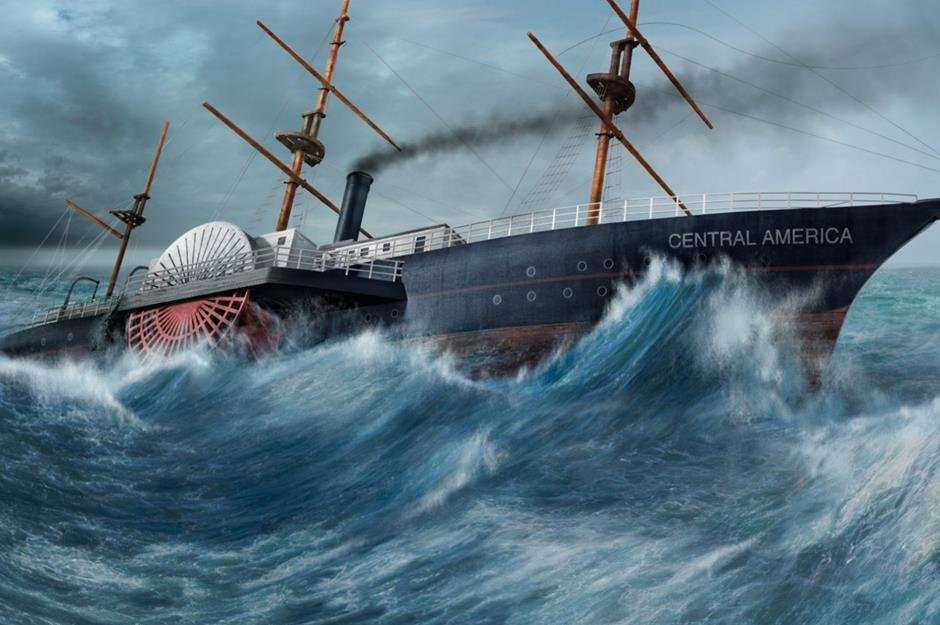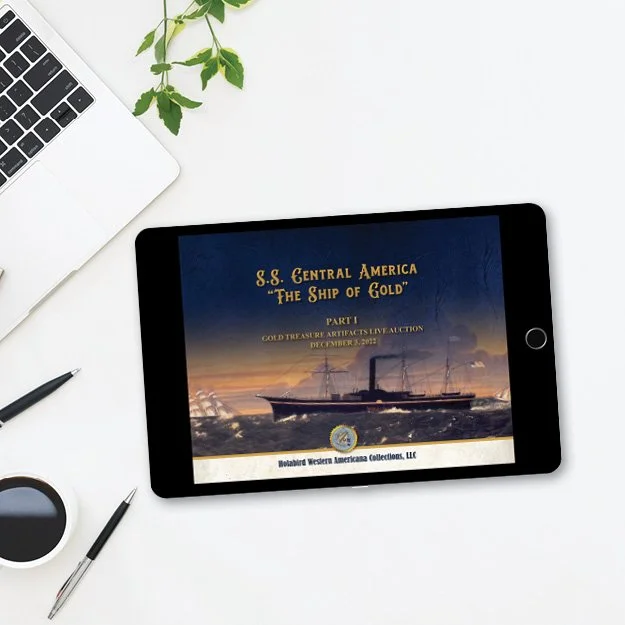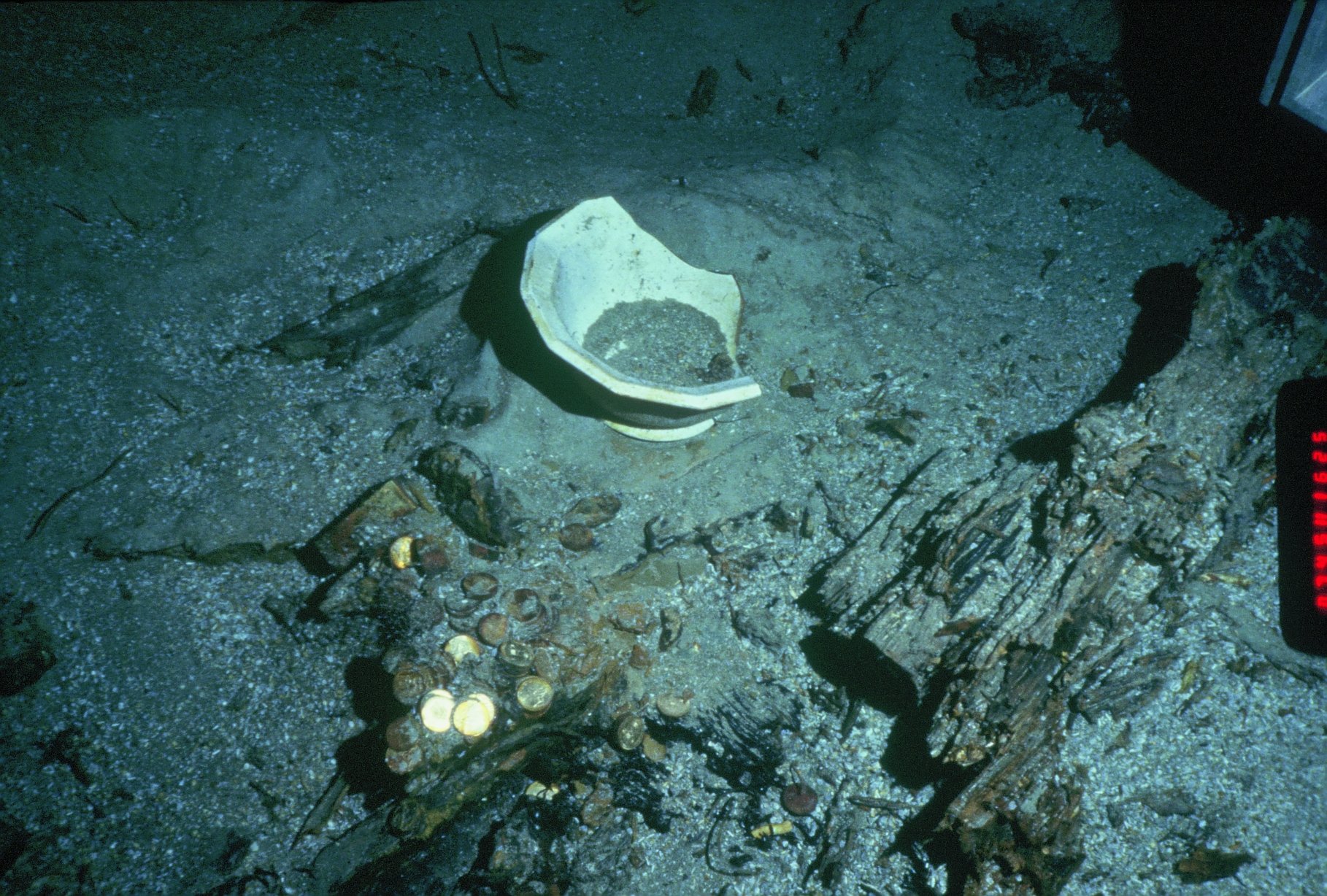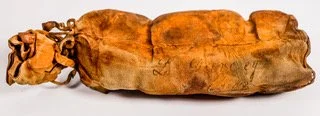
S.S. Central America
Shipwreck Artifacts Auctions
Auctions were held on
Part I - December 3, 2022
Part II - March 4 & 5, 2023
-

ONLINE AUCTION
Register, Bid, View Opening Bids. Choose your bidding platform:
*Please note buyers premiums are slightly higher on Live Auctioneers & Invaluable.
-

VIRTUAL CATALOGS
Read the historical essays and learn more about the infamous “Ship of Gold” and its recovered artifacts
SSCA Part I :
Part B (Gold Rush Related Material)
SSCA Part II
-

Prices Realized Part I

VIRTUAL CATALOGS

Once in a Lifetime Offering of Gold Rush History
-
A number of glass bottles were recovered from the debris fields of the SSCA during the first recovery period of 1988-1991. Most were recovered as examples, and there was no concerted effort to retrieve bottles, rather the effort was to retrieve examples of goods aboard the ship. Examples here include:
Clear glass decanters. These clear glass, fancy, diamond relief pattern decanters without top mechanisms were most probably for first cabin patrons. They were expensive in their day. About four were recovered. These decanters were all arrayed in the after part of the ship around the rim, along with much of the first cabin passenger goods, retrieved 1988-1991.
About three whiskey “fifth” cylinders were recovered. One is a classic “Patent” on the shoulder, and all three are essentially “black glass” (very dark green to amber). At least one is pontiled. The “Patent” variety has no embossing on the base. These were likely found in the after section of the ship also, 1988-1991. All appear to be of eastern glass manufacture.
Black Glass ales bottles were a very common bottle of the 1850’s-70’s before companies began embossing their own beer and ale bottles after technology allowed for a better understanding and use of various yeasts (Pasteur) and bottling techniques. These bottles were particularly prolific throughout California’s gold camps and the early camps of the Comstock, Reese River and White Pine mining rushes in Nevada. These were found in both the first class area in the first 1988-1991 recovery expeditions, and the other half in the second recovery from the debris field in 2014.
Two choice cold crème style ceramic jars were recovered, as well as the classic “Thorne” base painted jar with plain top. From the debris field c1989.
Wine bottles. Several riesling style bottles were recovered. These bottles carry the typical customary long tall neck. These bottles were unusual in 1857 in California, because they had a possibility of being imported all the way from Germany, and would have been very expensive onboard any ship. While these have been found in many California and Nevada mining camps of the 1850s to 1870s in many colors, the two recovered from the debris field of the SSCA in 2014 are green. A third is bound in wicker and a small size. This is customarily a high-priced, high quality content bottle, with contents perhaps among the great very sweet wines, such as a Trockenbeerenauslese. It was found during the 2014 expedition in the debris field.
-
California gold nugget stick pins
California gold quartz cufflinks set in gold (odd pair in one trunk 1990easton, 1991dement) (other pairs out of coin pile 2014)
“Heart” rings 2014 coin pile stuff
REGARD (ruby, emerald, garnet, amethyst, ruby, diamond) ring, 1989
California Gold Quartz Broach, engraved Sam Brannan, Jr.” 2014 debris field, in a pile with coins etc.
Signet rings 2014 coin piles from debris field
California gold nugget stick pins. Perhaps ten or so nugget stick pins were recovered, mostly from the 2014 coin pile debris field. At least four came from an original light cardboard that held four stick pins, all as they are found from jewelry shipments, thus were being sent for resale in New York or elsewhere.
California gold quartz cufflinks. At least six identical pair of California gold quartz in identical gold cufflink settings were recovered from the coin pile debris field of the 2014 expedition. These were also clearly meant for resale on the New York or eastern seaboard jewelry market.
-
Perhaps 100 or more pieces of jewelry were recovered from the SSCA project. Jewelry was found in the Dement (a Lieutenant from the Mexican War in California) and Easton trunks (Gold Rush bankers Darius, James and Edgar Mills’ sister) as well as in debris from specific sites that may have been attendant to a shipping area within the ship. Passenger jewelry was found in the various debris fields from both the 1988-1991 and 2014 SSCA expeditions. It is unquestionable that shipments were onboard of jewelry made in California bound for resale in New York or the eastern states. There were a reported four jewelers or jewelry store owners onboard the SSCA. One or more of these were carrying goods to be sold in the East. Among the resale jewelry were at least six identical-style and pattern pairs of California gold quartz set in gold; nearly a dozen similar size gold nugget stick pins (2014 coin pile debris field); several “heart” gold rings, each identical, and possibly other pieces.
Certainly some of the prizes are the large gold pieces, inclusive of the gold cross, the “REGARD” ring containing Ruby, Emerald, Garnet, Amethyst, Rose quartz , Diamond in that order. This style of ring originated with French jeweler Melleno in 1809, and was considered an “open declaration of love.”
One Gold Rush belt buckle was found in the debris field, recovered in 2014, and two suspender buckles were recovered from the Easton trunk.
Other prizes are certainly the California gold quartz pieces. Several California gold quartz broaches were recovered, including a spectacular piece engraved “To A. Roediger from his pupil Sam Brannan Jr.” (1845-1931) This piece has major significance in California history. Clearly this unique piece was made specifically for Sam Brannan for the express purpose of giving it to his son for his favorite teacher – a piece of the great California Gold Rush.
Sam Brannon (1819-1889) was a California pioneer and California’s first millionaire, according to historian Hubert Bancroft. Brannan left New York in 1846 in charge of a ship full of Mormons escaping persecution resulting from the murder of Joseph Smith in Nauvoo, Illinois. He brought with him a printing press, which became the first newspaper in California, the California Star. Brannan and crew, with knowledge of the Mexican War, had hoped to overthrow the local Mexican regime at Yerba Buena (later San Francisco), but arrived two days after the feat was accomplished by Montgomery and others.
Brannan opened a store in Sutter’s Fort, the very same store Marshall took that first nugget in 1848. With the Gold Rush afoot, he became active in politics. With law and order in disarray, and lacking a good local government, Brannan helped form the first Vigilance Committee in 1851. For this feat he was kicked out of the Mormon Church. He railed against paying taxes, because he claimed the government was too corrupt. Over time, he became a wealthy real estate magnate.
Brannan married in 1843. His wife Ann and Sam Jr, born in 1845, went with him to California in 1846. Three girls came later. In 1854 Ann and the children left for Geneva, Switzerland with enough money to live the highlife.
All did not go well for Brannan. While he was a wealthy landowner, he got divorced and was forced to pay half of his estate to his wife in cash. The complete liquidation of the estate nearly killed him mentally and physically, and he died a poor man.
Sam Jr went to school in Geneva and became a mineralogist and/or mining engineer, working in Mexico his entire career, until the collapse of the international silver market in 1896 financially broke him. He moved back to New York, died in 1931, and was buried next to his father.
It does not appear that Brannan Jr ever came back to California to visit his father. Roediger apparently was a teacher in Geneva, and there is no readily found record of him in California or the United States. Interestingly, Brannan family records indicate two of the early Brannan biographies were “fiction”. Some of the Brannan family papers survive in institutional holdings.
This piece was either in transit to Geneva by mail, by an express service, or was carried by a personal friend of Brannan’s to be shipped from New York or personally carried to Geneva.
Two matching engraved heavy gold rings were recovered, carefully and lovingly wrapped in cloth for protection, and placed within a leather gold dust style poke. Each ring carries initials but no surname, and none was found on the poke. These rings were most probably made of California gold by a California jeweler, bound for presentation once the Central America landed in New York.
-
1849 pistol in larger holster. 2014 debris field
Brass bullet moulds debris field 2014
Pictorial brass powder flasks
Powder horn debris field 2014
Firearms that were completely exposed to the deep underwater elements were near completely destroyed, and only skeletal remains were recovered. The pistol in the holster came from one of the debris fields. Interestingly, a pistol was also recovered from the Purser’s safe. The pistol in this display is apparently an 1849 with a barrel length of less than 7” held within a leather holster designed for a larger pistol, such as an 1851 Colt. No attempt was made to restore the weapon, as the visual appearance of the entire artifact is striking. Bullet moulds also did not survive in complete form, all recovered from the main debris field, along with three brass powder flasks, all with typical political-style pictorial emb
-
“Saloon” Brass Plaque
Passenger Room Key and identification Tag
Wine Room key and identification tag
New York to San Francisco luggage Tag
San Francisco to New York Luggage Tag
Panama Railroad luggage tag
Saloon brass plaque was found in the main pile in the after section in 2014. It was not readable until minor conservation in 2022 after it was removed from distilled water since its initial recovery.
The wine room key and brass identification tag, found in the Purser’s safe during the 2014 expedition, was similar, in that it also was unrecognizable until initial conservation in 2022.
The Passenger room tag and key was immediately recognizable, although it also was not conserved until 2022. Two room keys were found in the main pile of the cabin areas.
Luggage tags for each direction of the ship (southward or northward) were kept together found in the body of the ship. At first glance, they were a big encrusted mass, some found to be on a wire loop, others in a pile, where the wire loop may have diminished. Leather fobs were also found at the site, not conservable. Most of the northward bound, San Francisco to new York, A were picked up during the initial recovery expedition of 1988-1991. A portion of the southward bound, New York to San Francisco or Aspinwall, were recovered during the second expedition of 2014.
The Panama Railroad brass tag was found among the goods in the Purser’s safe in 2014.
-
Daguerreotype/Ambrotype portrait, amber tone
Daguerreotype portrait, black with high contrast, “Mona Lisa”
The photographs were found during the 2014 expedition in the coin piles of the debris field. The “Mona Lisa” photograph, subject of an extensive article in the Guardian in 2022, was found in the main pile of the ship, sitting atop a coal pile, almost as you see it today. It was buried slightly, and when the debris was being removed, it became exposed. The photos were conserved at Paul Messier, Inc., photographic conservators in Massachusetts. More than a dozen more cased photographs were found, but were unrestorable. Only one photo was in a trunk, illustrated in the blue coffee table book of the SS Central America treasure, but was not conserved and is now illegible.
The “Mona Lisa of antique photographs” is of particular interest. The article in the Guardian nailed some key aspects beautifully. This photograph is remarkable on a number of fronts. First, it is composed beautifully, with the woman sitting in a position that begs for an understanding of depth of field. The curls in her hair, the accentuation of the bust pose, all scream for a three dimensional depth perception. That is simply not present in other two dimensional photographs of the period, including those in this exhibit. In the Guardian article, the photograph was compared to a Leonardo DaVinci painting. This discussion is spot-on when reading the excellent analysis of Walter Isaacson’s recent biography of DaVinci, in which he details how the painter painstakingly experimented with, and found a way to use shading and color to render a three dimensional effect. That is exactly what separates this spectacular photograph from all the rest – a three dimensional interpretation of the photo through your eyes as if the woman was right in front of you.
-
Eleven bank notes were recovered from the Purser’s safe. Four are on display here.
A total of eleven bank notes were found inside the Purser’s safe, recovered in 2014. The safe itself sat out on the ocean floor, looking inviting, sitting off by itself near the after section of the ship where much of the Purser’s cabin and first class passenger debris had been ejected upon impact with the ocean floor in 1857. But as soon as the ROV manipulator arm touched it, the once strong cast iron dissipated into dust, leaving behind the contents of the safe: several leather gold pokes full of gold, bank notes, letters belonging to the Purser, two parcels of passenger receipts, several tickets from Aspinwall to Havana, newspapers, coin bags full of US dimes, quarters and halves, with one bag amounting to exactly $400 in small denomination US gold coins, obviously the ship’s “till” for needed cash for repairs or purchases and sailors wages along the multi-thousand mile route from Aspinwall to New York and return. The bank notes and all paper artifacts went to the Northeast Document Conservation center in Andover, Massachusetts for conservation after their discovery and recovery in 2014. This remarkable conservation effort restored a gooey, indiscernible mess into readable conserved documents, a first in document conservation history to our knowledge. The currency itself was worthless anywhere except the areas where it was issued, namely the New York area. It was probably received by the Purser at dockside in New York for last minute passengers purchasing tickets. The private bank nature of circulating currency broke down several times over time, resulting in the US Government’s entry into the currency business in 1861. In California, private bank currency was even more worthless – the custom there was all debts paid in gold.
-
Leather gold pokes contained gold dust and nuggets. All were found in the Purser’s safe in 2014. One poke contained the two engraved heavy gold rings carefully and lovingly wrapped in torn strips of cloth. Another poke had the name (signature) of the owner, “L. Dorsey” on the outside along with the weight of the contained gold. This was a custom used during the Gold Rush, passed down over decades, still used during the Alaska/Klondike gold rush.
The Dorsey poke is of particular interest and importance, as it reveals a slice of life often written about, but never before seen in a Gold Rush time capsule. Laurence Dorsey, or “L. Dorsey” as he signed his name, was an Irish immigrant. He came to New York via Liverpool in 1851 with his wife and three month old daughter Mary in 1851. It is possible he immigrated specifically for the Gold Rush, but history has left a question mark. He came to California, mined gold successfully in an unknown location. On August 20, 1857, he bought a second class ticket for New York on the SS Central America. His conserved passenger receipt survives. It was thought he was among those “lost at sea,” but instead, apparently passed through the crowds of people as the various rescue ships landed, and vanished into relative obscurity. It appears the family lived in New York State for a number of years. In 1867 he applied for, and was granted, United States citizenship, signing his application with the exact same signature found on the gold poke. In a mid-decade agricultural census, Dorsey and family are shown living in Easton, Washington County, over on the far eastern edge of the state along the Hudson River, today near the Saratoga National Historic Park. Dorsey had a farm with 8 milk cows, 9 other head of cattle, 7 horses, 2 oxen, 100 sheep and 4 pigs. They reported income from Rye, Indian corn, oats and barley. The household included Mary a son and another young daughter, along with two hired hands – one from Ireland.
-
The safe was sitting in the near debris field on the port side of the ship. It was originally in the Purser’s cabin up on the deck house. The theory is that the ship hit the bottom nose fist, exploded like a balloon, so the deck lifted off and went to the port side of the ship, along with the boilers. “There were a bunch of empty metal boxes strewn among the debris. When we heard there was a “safe”, we were not sure at first. But as we approached, we saw it had legs. We touched one of the legs with Nemo’s arms and it disappeared into a dust cloud of orange,” said Bob Evans, Chief Scientist for the project. “We worked the edges of the hinge and the door fell off.” The safe was unrecoverable.
Inside the safe were several bags of coins. Two were Purser’s bags of silver coin, about 9000 dimes, and a separate bag of quarters and halves. Inside the dime bag was another little bag with exactly $400 in small US gold. “I don’t think they ever used it. It was the cash box for the SSCA for coal, repairs, etc.,” said Evans.
A big pile of “black sludge”, as Evans put it, revealed two carefully wrapped bundles, each containing passenger receipts from New York to San Francisco and vice-versa. These receipts, numbering upwards of 800 pieces, were conserved as best as possible by the Northeast Document Conservation Center. A new passenger list is being constructed from the contained data.
-
Minors work Pants from the Dement Trunk.
Brooks Brothers undershirt from the Dement Trunk
Smoking jacket from the Easton trunk
The recovery and conservation of clothing from the wreck of the SS Central America is nothing short of miraculous. Careful, tedious sea floor recovery by human controlled robotic “hands” of the recovery vessel “Nemo” brought two full valuable trunks to the surface after 150 years during the first recovery expedition of 1988-1991. The items were conserved and restored by Ohio State University.
White Minors Work Overalls or Pants
The three items here are just a few of what was recovered, representing perhaps daily life in California. The denim pants, made of a material that resembles “sail cloth”, were hand made, presumably in California. Their buttons at the fly bear a remarkable resemblance to Levi’s of today, though there can be no assertion they are of Levi Strauss origin. All of their internal records were destroyed in the San Francisco earthquake fire of April, 1906. These pants were recovered from the Lieutenant John D. Dement trunk, a California Mexican War veteran.
The Strauss Company did not patent the now-famous “501 style” jeans until 1873. These pants, or overalls, were distinctive because of small rivets placed at the corners of pockets where tearing was likely to take place. The concept was “invented” by Reno tailor Jacob Davis, proposed to Strauss for partnership in 1871, and the rest is history. Levis are, and have been, a cultural mainstay in the western United States, gaining international appeal over time. Their hard-wearing durability has been the “go-to” pants for all of us outside activity people for more than a hundred years.
Strauss also had a large gold treasure shipment onboard the SS Central America bound for New York, probably received by his brother for the family business there. Trow’s 1860 New York City Directory even shows “Louis Strauss” living in San Francisco, while brother Jonas ran the New York company. The Company did so well that nearly monthly gold shipments were made to new York, often larger than many of the banks! In May 1858, they shipped $118,399.07 in gold, the third largest gold shipment on the ship John L. Stephens, behind Wells Fargo’s $411,000.
Brown Smoking Jacket and Brooks Brothers Undershirt
The brown smoking jacket belonged to Ansel and Addie Mills Easton. Addie Easton was the sister of the wealthy Gold Rush banking family of Darius, James and Edgar Mills. Easton and his new wife were headed to New York for the start of their honeymoon. This was perhaps the most wealthy of all SS Central America passengers. Both survived, though neither knew their partner had survived until rendezvousing in Norfolk. The smoking jacket is typical of such, used in any private saloon or smoking room.
Brooks Brothers Undershirt
Classic cloth undershirt bearing the Brooks Brothers emblem.
There were several undershirts found. Possibly just purchased in San Francisco, since they appear to be unworn. The Brooks Brothers were an American clothing staple since 1813. The New York company was well known for two centuries for its quality clothing. The undershirts were found onboard the SS Central America in the Lieutenant John D. Dement trunk. Both were conserved and restored by Ohio State University. It is unknown if any other similar Brooks Brothers clothing survives.
-
Wells Fargo Treasure box lid
This Wells Fargo treasure box lid has the Company’s name impressed into the wood, addressed to the Wells Fargo New York office. It was found in the main gold treasure pile, upside down, thus protecting the letters, recovered in 2014. It represents the oldest Wells Fargo treasure box component extant, and is unquestionably the most important Wells Fargo treasure box known today. Unfortunately, the sides did not survive. The gold coins and ingots were shipped in these treasure boxes. Each bank used their own. The Wells Fargo boxes were all sealed with red wax seals bearing the name “Wells Fargo, San Francisco”. These seals were placed on top of every screw that sealed the boxes. Several of these seals survived and were recovered and conserved.
Sather - Church Treasure Box
One of the many unique discoveries from the SS Central America wreck was a complete Sather & Church treasure box. The treasure box, while not as fancy and embellished as the Wells Fargo treasure box lid, was nonetheless complete. The red wax seals placed carefully along wood box side edges and over screws sealing the box are all embossed “Sather & Church San Francisco” in the same style as the Wells Fargo seals. This was standard procedure for any treasure shipment – each treasure box was “sealed” with an identifying wax seal to insure that no tampering took place. Today, coin bags are “sealed” from the US Mint or other shipping centers to insure integrity and safety of the contents.
Sather & Church were classic Gold Rush bankers. Upon the advent of the new Gold Rush in California, New York bankers anxiously scampered to gain an “entrance” into the incredibly wealthy new California gold market. Indeed, most of the New York bankers threw their hands into this giant new gold cataclysm. The New Yorkers were first, because of their easy access to the ports along Manhattan where the gold ships landed daily. But the Philadelphia bankers wanted into the fray too. So entered Francis Drexel, a successful Philadelphia banker who offered his employee Peder Sather and partner Edward Church a partnership, if they would open a bank in San Francisco. The pair opened a bank in 1850 as Drexel, Sather & Church, and by 1857 were known as Sather & Church. Their bank remained successful, and they were later bought out by the Bank of California.
This Sather & Church treasure box is the oldest complete California Gold rush treasure box extant.
-
Item description
Suggested reading
Ship of Gold
By Gary Kinder, 1998
Final Voyage of the Central America
By Normand Klare, 1992
America’s Lost Treasures
By Tommy Thompson, 1998












